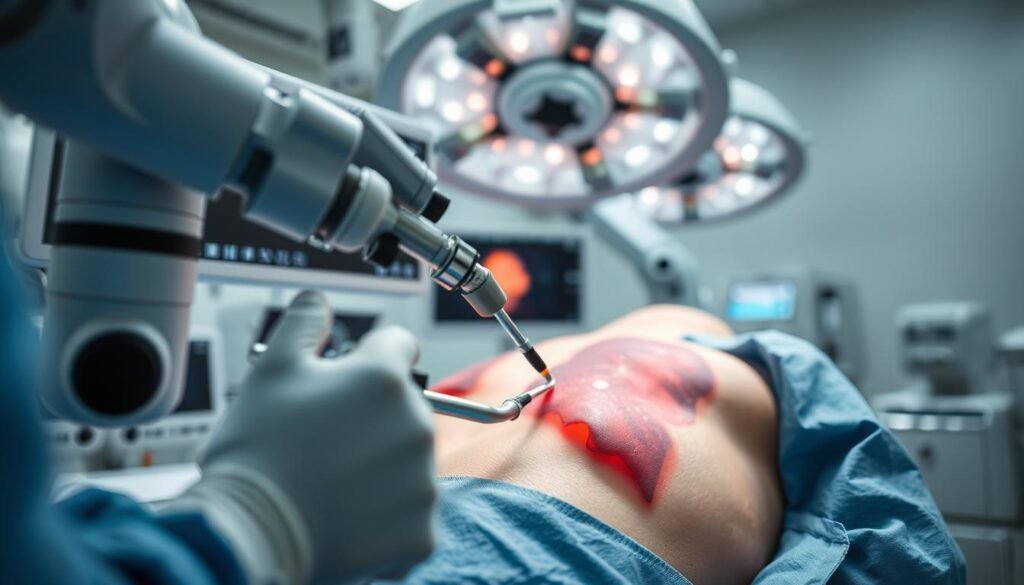Thoracic surgery is vital in treating lung cancer, being the key to many successful recoveries. In the USA, people with early-stage non-small cell lung cancer find surgery boosts their recovery odds. It’s more effective than other treatments. Surgery for lung cancer includes various techniques. These are lobectomies, pneumonectomies, and wedge resections. They remove cancer and help diagnose and stage the disease.
Understanding thoracic surgery is crucial for patients on their lung cancer journey. We aim to give you a full view of what this surgery involves. You’ll learn about the types of lung cancer, the common surgeries, and new techniques that help patients heal faster. This knowledge lets patients and their families make smart choices during a tough time.
Key Takeaways
- Thoracic surgery is crucial for lung cancer treatment with curative intent.
- Lobectomy is the most common procedure performed to treat lung cancer.
- Pneumonectomy and wedge resection are alternative options based on patient suitability.
- Minimally invasive techniques like VATS offer similar cure rates with reduced recovery times.
- Understanding surgical procedures can help patients navigate treatment options effectively.
- Postoperative care is essential to manage complications and ensure recovery.
Understanding Thoracic Surgery
Thoracic surgery focuses on the organs in the chest, like the lungs, heart, and esophagus. It is often used in the battle against lung cancer. The goal is to remove cancerous tissue, which can help cure patients.
Definition and Purpose
This type of surgery is a specialized field. It treats conditions like lung cancer. Thoracic surgeons use traditional and less invasive methods to maximize safety and effectiveness.
These techniques aim to remove tumors safely. They help improve the chances of surviving lung cancer. The decision for surgery depends on the patient’s health.
Overview of Thoracic Organs
The thoracic organs are vital for breathing and blood circulation. The lungs help with oxygen exchange, and the heart circulates blood. They are key to our health.
Surgical procedures can greatly affect these organs. Techniques like VATS offer a less invasive option with faster recovery. You can learn more about these options here.
Types of Lung Cancer
Lung cancer comes in two main types: non-small cell lung cancer (NSCLC) and small cell lung cancer (SCLC). Knowing the type is key for the right treatment plan, especially when surgery is considered.
Non-Small Cell Lung Cancer
Non-small cell lung cancer makes up about 85% of all lung cancer cases. It includes adenocarcinoma, squamous cell carcinoma, and large cell carcinoma. For people with NSCLC, surgery might be needed. Options include lobectomy, segmental resection, or pneumonectomy. Surgery is often the go-to option for early-stage patients.
It’s important to talk about treatment options, like lung cancer surgery, to come up with the best plan.
Small Cell Lung Cancer
Small cell lung cancer grows faster than non-small cell lung cancer and is often linked to smoking. For some with limited-stage disease, surgery might be an option. Yet, most with extensive-stage SCLC might not be candidates for surgery. Treatment usually includes chemotherapy and radiation therapy.
Knowing the cancer type is crucial for crafting an effective treatment strategy.

Importance of Thoracic Surgery for Lung Cancer
Thoracic surgery plays a key role in fighting lung cancer. It aims at curing or easing the disease. Knowing the difference between curative and palliative surgeries helps plan the treatment better. Some surgeries remove the cancer entirely. Others focus on reducing symptoms and making the patient more comfortable.
Curative vs. Palliative Intent
Surgeries with a curative intent aim to get rid of tumors completely. This increases the chance of living longer. For example, a procedure called lobectomy can often cure a type of lung cancer known as non-small cell lung cancer. On the other hand, palliative surgeries focus on easing problems and reducing pain. They may not extend life but greatly improve it.
Staging and Diagnosis through Surgery
Surgery is crucial for staging and diagnosing lung cancer. Surgeons sometimes take out lymph nodes to examine them. This helps figure out how far the cancer has spread. Knowing the stage of the cancer is essential for deciding what treatment comes next. The insights from surgical staging make future therapies more effective.
Common Surgical Procedures
There are different surgeries to help fight lung cancer. Each one aims to take out the cancer and save as much of the lung as possible. The surgery type depends on the patient’s health and the tumor’s details.
Lobectomy
A lobectomy takes out a whole lobe of the lung with cancer. It’s needed when cancer stays in one lobe. By using minimally invasive techniques, surgery recovery is faster. Most people get back to their usual activities in 3 to 4 weeks.
Pneumonectomy
A pneumonectomy removes a whole lung with widespread cancer. It’s a big surgery. But, surgeons use special methods to help patients recover better and quicker. Despite a longer healing time, good care after surgery helps patients get strong again.
Wedge Resection
Wedge resection cuts out a small, wedge-shaped part of the lung around the tumor. It’s best for small or early-stage tumors. This method keeps more lung working and shows why personalized surgery matters.

| Procedure | Scope of Surgery | Typical Recovery Time |
|---|---|---|
| Lobectomy | Removal of one lung lobe | 3-4 weeks |
| Pneumonectomy | Removal of an entire lung | 4-6 weeks |
| Wedge Resection | Removal of a small section of the lung | 3-4 weeks |
The surgery choice depends on the tumor and lung health. Good planning helps achieve the best results for lung cancer patients.
Minimally Invasive Techniques
Minimally invasive techniques are changing how doctors do thoracic surgery. They are less painful and help patients recover faster. Video-assisted thoracoscopic surgery (VATS) and robotic-assisted surgery are at the forefront. These methods use the latest technology to perform surgeries with little harm to the body.
Video-Assisted Thoracoscopic Surgery (VATS)
Video-assisted thoracoscopic surgery (VATS) makes use of small cuts. A camera and tools go through these cuts into the chest. This lets doctors see inside in real-time, allowing them to accurately remove lung tissue.
The benefits of VATS are many. It leads to smaller scars and less pain after surgery. Patients can often leave the hospital the following day. They usually get back to their normal lives in a week or two.
Robotic-Assisted Surgery
Robotic-assisted surgery gives surgeons more precision. Using robotic tools, surgeons have better control over delicate operations. This leads to key advantages.
- Enhanced dexterity and visualization.
- Potentially lower rates of complications such as bleeding and air leakage.
- Personalized approaches to individual patient anatomy.
Both video-assisted and robotic-assisted surgeries are great for lung cancer treatment. They represent a move toward less invasive methods. People having these surgeries often have shorter recoveries and better outcomes.

Preoperative Evaluations
Preoperative evaluations are key in checking if a patient can safely have thoracic surgery, especially with lung cancer. These checks look closely at lung health and the patient’s overall condition to guide the surgery plan. They make sure the surgery fits the patient’s health needs.
Lung Function Testing
Lung function tests are crucial for checking a patient’s breathing system health. They measure important things like forced expiratory volume (FEV1) and how well lungs handle carbon monoxide (DLCO). Studies show DLCO better predicts surgery risks than FEV1. This makes it very important for before-surgery checks.
The British Thoracic Society has set the lowest numbers needed for FEV1: 1.5 liters for removing a lung lobe and 2 liters for removing a lung. The American College of Chest Physicians focuses on predicted post-surgery values (%PPO) rather than just fixed numbers. This helps doctors figure out surgery risks better.
Assessment of Overall Health
Checking overall health is also vital, alongside lung tests. This looks at heart health, past illnesses, and issues like diabetes or liver problems. Substance use is also reviewed. Tests like the Shuttle Walk Test show how well patients use oxygen.
Doing a full pre-surgery check, including physical exams, helps prepare better for surgery. Understanding a patient’s health before surgery leads to better surgery results and fewer issues afterwards.
Postoperative Care and Recovery
After lung cancer surgery, good care is key for a smooth recovery. It’s important to watch for complications to stay safe.
Common Complications
There are several complications patients might face after surgery. Spotting and treating these early is crucial. Issues can include:
- Infection
- Bleeding
- Respiratory issues
Big surgeries, especially for those in poor health, need close watch early on. Using ERAS programs decreases complications and betters life quality.
Pain Management Strategies
Managing pain well is crucial for recovery. Doctors start with prescription meds for pain. Then, patients move to over-the-counter drugs. Adding physiotherapy, like CPAP and incentive spirometry, prevents lung problems.
Moving quickly after surgery helps avoid blood clots and pneumonia. Teaching patients to handle constipation with a good diet and fluids is also important.
Patients usually leave the hospital by 11 a.m. on discharge day. Complications like lung leaks or irregular heartbeats can extend stays. Once home, keeping in touch with doctors and adjusting pain meds are vital steps. Using a Recovery Tracker for the first ten days is recommended. For more on treatments, visit this resource.
Adjuvant Therapy After Surgery
After lung cancer surgery, patients might get extra treatment known as adjuvant therapy. This method deals with lingering cancer cells and cuts recurrence risk. It includes radiation and chemotherapy, tailored for each patient.
Radiation Therapy
Radiation therapy uses intense beams to kill cancer cells. It’s chosen based on tumor stage and pathology results. Around 19.7% of patients get radiation to the mediastinum post-surgery. It’s vital for hitting spots where cancer may remain, helping patients live longer.
Chemotherapy Options
Chemotherapy often combines drugs to stop cancer from growing. Nearly 80% of patients get adjuvant chemotherapy. It boosts survival significantly. For example, patients without node pathology have a 70.8% survival rate, much higher than 39.7% for those without this therapy. New drugs like atezolizumab for some lung cancers have made treatments even more effective.
| Characteristic | Percentage |
|---|---|
| Adjuvant Chemotherapy | 79.8% |
| Mediastinal Radiation Therapy | 19.7% |
| Prophylactic Cranial Irradiation | 10.8% |
| Overall Survival (5-Year Rate) | 53.4% |
| Disease-Free Survival (5-Year Rate) | 46.9% |
Using both radiation and chemotherapy after surgery is crucial. It improves chances of survival. These treatments are chosen with care to manage the disease effectively.
Conclusion
Thoracic surgery is key in treating lung cancer. It offers many choices, from lobectomy to less invasive surgeries. These include video-assisted thoracoscopic surgery and robotic-assisted surgery. These methods help patients have better results.
Surgery works well, especially for early-stage non-small cell lung cancer. It can often cure the cancer in these cases.
Getting the best outcome means using a team approach. This ensures care is designed just for the patient’s needs. Teams of experts work together to give the most effective treatment. It’s also critical to evaluate patients carefully before surgery and provide thorough care after.
Recovery and fewer complications are the goals of good preoperative and postoperative care. This makes the patient’s journey smoother.
Knowing all about thoracic surgery empowers both patients and doctors. As surgery methods and teamwork improve, so do survival rates and life quality for lung cancer patients.